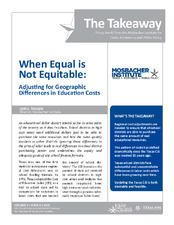| dc.creator | Taylor, Lori L. | |
| dc.date.accessioned | 2015-04-15T20:39:37Z | |
| dc.date.available | 2015-04-15T20:39:37Z | |
| dc.date.issued | 2015-04 | |
| dc.identifier.uri | https://hdl.handle.net/1969.1/153777 | |
| dc.description.abstract | An educational dollar doesn’t stretch as far in some parts of the country as it does in others. School districts in high cost areas need additional dollars just to be able to purchase the same resources and hire the same quality teachers as other districts. Ignoring these differences in the price of labor leads to real differences in school district purchasing power and undermines the equity and adequacy goals of any school finance formula. Texas was one of the first states to incorporate regional cost differences into its school funding formula with the Texas Cost of Education Index (CEI), but the CEI has not been updated since its creation 25 years ago. The pattern of costs has shifted dramatically in Texas since then and school districts face substantial and uncontrollable differences in labor costs which have been growing over time. This article explores a few methods that could be used to update the Texas CEI and concludes that whatever strategy is chosen, updating the Texas CEI is both desirable and feasible. | en |
| dc.language.iso | en | |
| dc.publisher | Mosbacher Institute for Trade, Economics & Public Policy | |
| dc.subject | Texas CEI | en |
| dc.subject | education costs | en |
| dc.subject | equitable and adequate | en |
| dc.subject | geographic cost differences | en |
| dc.subject | school funding | en |
| dc.title | When Equal is Not Equitable: Adjusting for Geographic Differences in Education Costs | en |
| dc.type | Article | en |
| dc.contributor.sponsor | Bush School of Government and Public Service | |


